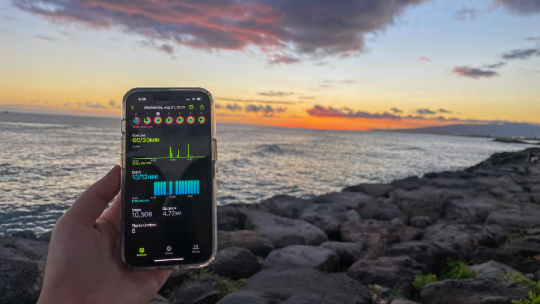First, personal trainer and HMSA community well-being analyst Jordan Ng showed us how to start a home workout routine. Then, we followed him outside to learn about green exercise, or using the natural environment to stay active. Now, Ng is back to answer five frequently asked questions about fitness.
Even if I don’t break a sweat, does it still count as exercise?
I know it seems like not sweating means you didn’t get a good workout, but that’s not true. Any movement that engages the muscular system, increases the cardiorespiratory response, and activates the nervous system is good for you. Some people love that feeling of getting a good sweat on, but it’s not necessary for a good workout. Breaking a sweat is just your body’s response to cool down. I mean, sometimes I sweat just lying down. Getting yourself to move is key, and as you begin to get more comfortable with exercise, the sweat will come, too!
Is it important to warm-up and cool down?
If you’re planning to go for a quick, leisurely walk, then a warm-up and cool down may not be needed. However, if you’re about to participate in moderate to high-intensity exercise, a warm-up and cool down may be beneficial. It’s important to listen to your body.
I find myself needing to warm-up even before a round of golf. Generally, for the warm-up, which is five to 10 minutes, you want to elevate your heart rate and activate the primary muscle groups you’ll be using during the activity. Once you’re finished exercising, a five-to-10-minute cool down will help decrease the heart rate. It’s also a good idea to include some static stretching during the cool down period if possible.

Are fitness trackers helpful?
Fitness trackers are a great tool to provide insight and feedback on your daily physiological functions. Unfortunately, based on current research, most fitness trackers aren’t 100% accurate and provide variability in measurements such as heart rate, calories burned, and steps. However, it can offer general knowledge about those variables and can keep you consistent in moving more.
For example, a fitness tracker can give you an idea of how many steps you take per day. It might not be 100% accurate, but it can help you set a step goal. For example, if you want to hit 8,000 steps a day, then the fitness tracker can help keep you on track.
Do I need to invest in more expensive workout clothing to get a better workout?
What you wear normally has no direct correlation to getting a good workout. However, one thing I’ve noticed is that when one is consistent with exercise or activity, their confidence grows and they begin to invest more in fancier workout gear. But what you wear won’t have a major influence on any physiological aspects of your workout. I believe it can have a slight impact psychologically in alignment with the saying “look good, feel good, perform good.”
Aside from working out, what else can I do to take care of my health?
There are many things we can do to take care of our health. Working out is just one component of health and I think many of us recognize that nutrition is just as important. Other things you can do include:
- Taking a daily multivitamin.
- Getting at least 30 minutes of sunlight every day.
- Staying hydrated.
- Getting adequate sleep.
I know that trying to incorporate all these things at once can be overwhelming, so start small and focus on one area at a time. Like I mentioned, start with 10 minutes of any type of movement and as you begin to build this habit, you’ll realize that you want to do more. For nutrition, maybe start adding something dark green (not mint chocolate chip ice cream) to one of your meals. For sleep, start winding down for bed 15 minutes earlier or keep your phone away from your reach. Before you know it, these little steps will get you up that mountain.
Get moving
Here are some fun fitness stories and ideas to get you moving.




